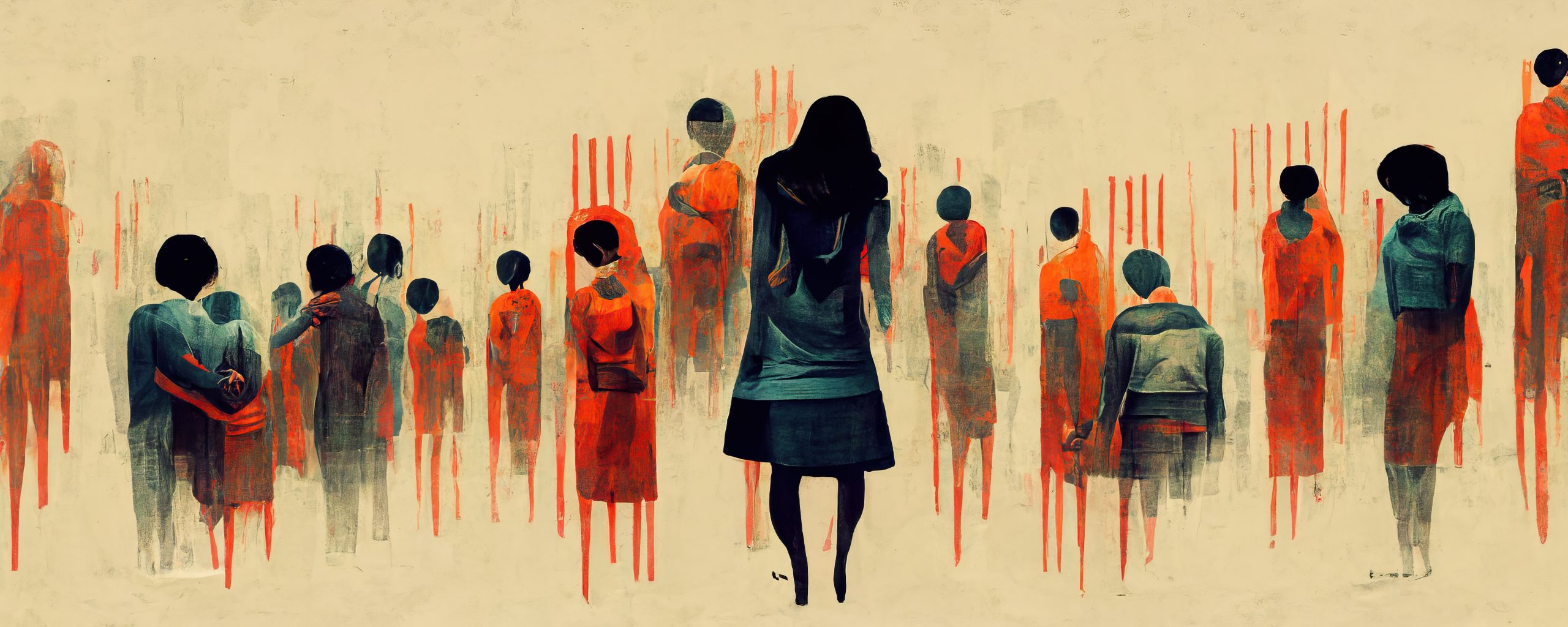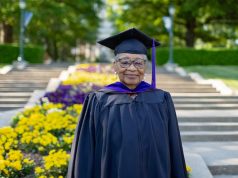
By Alaina Bookman | abookman@al.com
This is another installment in Birmingham Times/AL.com/CBS42 joint series “Beyond the Violence: what can be done to address Birmingham’s rising homicide rate.” Sign up for the newsletter here.
Justin Bowlin, a Jefferson County District Attorney’s Office investigator, said he is seeing a rise locally in human trafficking cases both because the industry is profitable and because of the increase in awareness and resources for people to report.
“We do get calls often about potential cases. I do think that the number is going up because of the outreach that is being done. Awareness is getting out there,” Bowlin said.
Dothan residents Marilyn McFalls and her two granddaughters are human trafficking survivors fighting for the protections of others like them.
In 2021, McFalls created Tassel to the Left, an advocacy program to help other victims of human trafficking and those in need of mental health resources, to continue to help herself and her granddaughters heal.
“When you put your tassel to the left, you graduate and you move forward in life. I endured sex trafficking myself. I endured abuse as a child myself. And so I’ve never believed in myself, I never believed that I could achieve the things that I have achieved. I graduated from high school, I graduated from college, I took nursing classes.”
Judicial Response
Advocates and survivors say broken systems enable traffickers to target people who are unhoused, economically marginalized or traumatized. Experts say human trafficking needs solutions that are just as pervasive and resilient as the problem itself. In Alabama, advocates have been working toward solutions for decades, but say it can be tough for law enforcement, courts and communities to get on the same page.
“I see people like my grandchildren that, because of the sex trafficking that they endured, they’re stuck in the past. They’re stuck not being able to move on,” McFalls said. “It doesn’t end with just rescuing them from the trafficking. It’s a lifetime of rebuilding their self esteem, their mental health and moving them forward in life.”
The National Human Trafficking Hotline said 26,872 people reported being a victim of human trafficking across the United States between January 2020 and August 2022.
Sex trafficking victims were almost always trafficked by someone they knew: 44 percent were family members, 39 percent were intimate partners, 6 percent were employers and 5 percent were illicit substance providers, according to experts.
Agnes Chappell, now retired, was a judge at Jefferson County Family Court for 19 years, where she heard child neglect and abuse cases.
“In at least one or two of those child neglect and abuse cases, it turned out that the child was being trafficked, sometimes by the parent, maybe being the mother, who’s trafficking her child to help pay her rent. So I have seen a couple of those cases,” she said.
In Dec. 2023, a Montgomery woman, Laporchie Howard, 27, was sentenced to 10 years in federal prison for the charge of sex trafficking a minor. The victim was a runaway who was invited to live at Howard’s apartment in exchange for commercial rape.
People who are homeless or don’t have stable housing, have mental health challenges or struggle with substance abuse are often at higher risk for trafficking.
“Runaways and those who are vulnerable, generally, can be easily trafficked,” Chappell said. “We realized that when you get hungry and you’re running away it’s like a [procurer] can sense that they see a child on the street and they can see that that child is in need. They befriend them, and then they start violating them and using them to sell their drugs and other awful things.”
Courts and law enforcement don’t always treat trafficking survivors as victims, Chappell said. Some are prosecuted for prostitution, drug possession and theft.
“Even as late as 2013 agencies, like first responders, those in the healthcare industry, child protection agencies, law enforcement, were not really looking for human trafficking. There was no screening protocol to look for human trafficking. If you ended up with law enforcement, then they just saw the client as what the client was. Nobody was looking for any underlying causes. There was no support mechanism for the victim,” Chappell said.
The Trafficking Victims Protection Act, the first comprehensive federal law to address trafficking, was enacted in 2000. The law included methods of prevention, protection, prosecution and set penalties for violations including life imprisonment.
Law Enforcement Response
Bowlin said that local law enforcement is working to better recognize and prosecute trafficking cases.
“We’re seeing a more trauma informed response with newer officers. We’re seeing more cases brought from officers who have done the training.”
Bowlin said law enforcement uses a wide range of methods to determine if a crime is human trafficking, however, each case is meant to be handled with the same care and patience by upholding survivors’ autonomy and dignity.
“These are people’s lives at stake. This is someone’s mother. This is someone’s wife, somebody’s daughter. Somebody, somewhere loves this person. It is our duty as law enforcement to treat these people as human beings and we have a duty to always try and answer that call for help with professionalism, with courtesy, no matter how many times they call for help, and treat them the way we would want our loved ones to be treated,” Bowlin said.
Today, law enforcement training incorporates discussions about the importance of language access, understanding cultural norms and having trauma-informed advocates present during interactions with survivors.
“At one time in the [law enforcement] academies, this was a topic that wasn’t talked about at all. We’ve still got a tall mountain to climb, but we’re climbing it,” Bowlins said. “I do think our training has evolved very well in the right direction. We are making great strides in including other cultures…Those are things we just didn’t have 20 years ago.”
Bowlin’s office is working to put more human trafficking awareness signs on buses, in airport bathrooms and public buildings.
Investigators also conduct training in schools, churches and hotels to provide tips on how to avoid falling prey to sexual exploitation and raise awareness for signs of trafficking.
Bowlins said possible trafficking indicators among victims can be visible neglect or signs of physical abuse, running away frequently, new clothing or jewelry with no explanation of how they got it or change in behavior.
Some common human trafficking misconceptions are that trafficking is only an international problem, traffickers are easy to spot, sex workers cannot be trafficked or that all human trafficking victims are arrested.
Anyone who suspects human trafficking is taking place or believes they may be a victim of human trafficking should contact their local law enforcement as soon as they can.
“The worst thing you could do is nothing,” Bowlins said. “The best thing that you could do is get as much information as you can without putting yourself in harm’s way and report that directly to the police. That will get the fastest response.”

Alabama Trafficking Resources
From 2020-22, the top referral request in sex trafficking situations was for shelter or housing, according to National Human Trafficking Hotline data.
Holly Bunn, chief development officer of the WellHouse, said she hopes to see more policy changes to protect victims like legally protecting those who committed crimes as a result of their trafficking exploitation, improving child welfare systems and establishing harsher consequences for traffickers and johns.
“We really need law enforcement and other organizations focusing on finding where trafficking is happening, identifying victims and explaining to them what their options are for accessing services,” Bunn said. “We know from estimated numbers that tons of people are being trafficked, so there’s a gap there and it’s hard to say why. It’s a hidden crime and [victims] may be hard to find.”
The WellHouse was founded in 2010 as a human trafficking shelter and resource center for women.
“There are some commonalities that are true among the population of sex trafficking victims. Trafficking victims almost always are victims of childhood sexual abuse. They come to us with complex trauma. Most are beginning a journey of addiction recovery, they may have a lack of education or lack of life skills because of their trauma,” Bunn said.
From 2021-22, advocates worked with 61 residents who were sexually abused as a child, 34 experienced childhood emotional abuse and 17 were physically abused as a child, according to the WellHouse Restoration Report.
“Trafficking typically begins in the teenage years. And we’ve seen that to be true with adult women that we’ve served,” Bunn said.
WellHouse services include:
- Case management
- Onsite clinic
- Therapy
- Addiction recovery classes
- Life skill classes including sewing, art, cooking, nutrition and exercise
- Short term housing
- Long term housing
- Employment opportunities
- Identity document retrieval
- Religious services
- Education services, including GED readiness classes
- Mentorship program
- Minor program
Women seeking WellHouse services do not need to provide proof of homelessness or identification. The WellHouse takes in survivors from anywhere in the country.
From 2021-22, WellHouse advocates served 85 women, 17 were children; 26 women attended on-site Alcoholics Anonymous meetings, 12 women graduated from the program, 10 women found employment and six moved to transitional housing.
“We’ve learned from the women we’ve served what works best, the way they grow and progress through their healing and what works for them. We’ve seen success with this type of setup,” Bunn said. “It’s a good way to continue building and working towards true independence in a community.”
Life After Trafficking
McFalls adopted her two granddaughters in 2012 and soon after enrolled them into a program, More Too Life, to heal their trauma and get back on track.
Brook Bello, Founder and CEO of More Too Life, an international program that provides trafficking victims and survivors resources, and author of Shame Undone, has been a mentor to McFalls and her granddaughters for 12 years.
In addition to More Too Life, Bello created court-appointed educational courses to prevent sexual exploitation and gender-based violence. The course, Live Until You Die, is a program for women charged with prostitution.
“Unfortunately, with the rate of the challenges that young people have to face, they’re faced with things that are really difficult, which can relate to different peer pressures and different challenges and different abuses that put them in positions where they’re just not safe and they just haven’t discovered good choices nor how to define or identify safe people,” Bello said.
“A high percentage of these women were being trafficked way before they were 18. They never had supportive services, most of them. Should they actually go to jail for that? Or should they have the opportunity to go through programs like ours, for diversion but also have different opportunities to support their mental health, life and identity discovery.”
Bello is also a survivor of rape and neglect who has used her experience to help others heal and grow. When she was 12, Bello ran away from home. Vulnerable, she was kidnapped, beaten into submission, forced into drug addiction and human trafficking.
Bello said she escaped trafficking and survived by faith. She later became an actor.
“I pushed everything back like it never happened and I had a lot of challenges,” Bello said. “I saw issues of trafficking all around Hollywood, so I ended up helping a lot of kids. I had a lot of challenges mentally, anxiety, depression, thoughts of suicide. I survived suicide. And I said there’s got to be more to life. I started by just rescuing kids and working with law enforcement.”
Despite the challenges Bello faced, she persevered and became an actress, author, minister and an awarded advocate.
In Sept. 2023, McFalls wrote letters to Congress and the White House advocating for better support systems and protections for victims of trafficking.
The McFalls sisters were often revictimized while receiving inpatient care at hospitals and co-ed mental health facilities after being trafficked, their grandmother said. She believes facilities need better oversight.
Despite their many setbacks, McFalls’ granddaughters are working hard to get back on track. They have jobs, are making friends and pursuing their passions.
“When [my granddaughter] came to me, she could not read. She could not color. She did not even know Christmas songs at the age of nine,” McFalls said. “Now she can read. She can draw. They both graduated from high school. I have seen milestone after milestone after milestone. I’ve got them in a program where they’re going to learn work skills.”
“It took forty years of my life to heal,” McFalls wrote in her letter to the White House, “I give my life to helping other victims to thrive.”
The National Human Trafficking Hotline can be reached at 1-800-373-7888. Operators can also be reached by texting BEFREE to 233733. Operators are available 24/7 in more than 200 languages.




